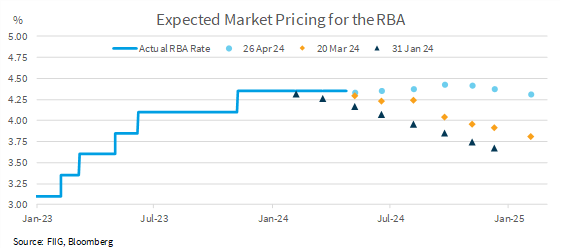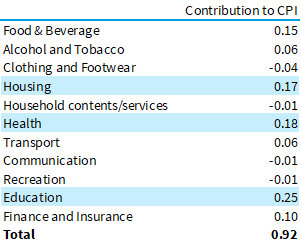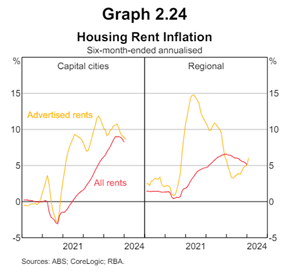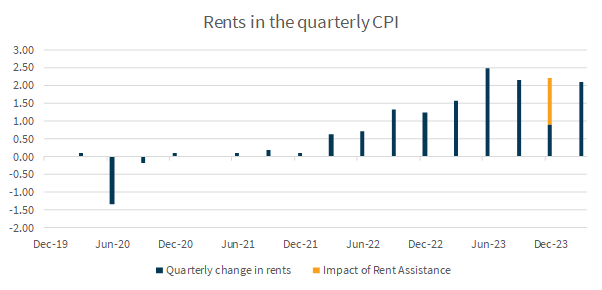by
Philip Brown - Head of Research, FIIG Securities | Apr 28, 2024
The CPI result for the March quarter was ugly. Although annual inflation continues to drop, the so-called “last mile” of CPI is proving hard to eradicate. The last mile concept suggests that it’s comparatively easy to bring inflation down from exceptionally high numbers to around 4% per annum, but getting it down that last part that is needed to credibly claim success is incredibly hard. It’s proven hard historically and proven hard recently in other countries.
This result saw the annual headline CPI drop from 4.1% to 3.6%, but it did so on the back of a 1.0% rise in the March quarter. The Trimmed Mean CPI was also higher than anticipated, at 1.0% in the quarter and 4.0% on the year. (Trimmed Mean CPI is a measure that excludes the items moving most quickly and attempts to capture the underlying trends in CPI.)
The RBA did not have public forecasts for this quarter’s inflation – the RBA does have public forecasts for inflation over the year to June. These March numbers were broadly in line with the trajectory of the RBA forecasts, but just a little higher than the RBA anticipated. The RBA has forecast annual headline inflation will have dropped to 3.3% by June (so down another 0.3% from this print) and that Trimmed Mean CPI will have dropped to 3.6% by June (so down another 0.4% from this print).
The 2Q 2023 CPI data was fairly good (i.e. low). That means that the annual numbers will likely not fall far in Q2 2024. The change in the annual CPI data can be thought of as removing the quarter that is now more than a year old and replacing it with the new data. Since the headline CPI in 2Q 2023 was +0.8% and the Trimmed Mean CPI in 2Q 2023 was +0.9%, to get a fall of 0.3% in headline and 0.4% in the Trimmed Mean, the 2Q 2024 CPI would need to be in the order of 0.5% in the current quarter. That would be the lowest print since the June quarter of 2021. That’s just plausible, but quite unlikely. It's far more likely that the RBA revises their forecasts for CPI a little higher.
Based on the CPI summary numbers alone, the RBA is almost guaranteed to consider a rate rise, and there’s just a small chance that they follow through. The market pricing of the RBA has shifted substantially and reflects that new reality.

If inflation is so high, why would the RBA wait? Why not just raise rates at the May meeting? There are two threads to the argument for the RBA to hold back.
The first is that the cash rate is already very high and is already doing significant work to slow the economy. Any further rate rises would take the cash rate into highly contractionary levels and would exacerbate the current cost-of-living issues in Australia. The full impact of rate hikes is felt many months (around 12 to 15) after the decision is made. The cashflow impact of a change isn’t normally felt until around month three. The mortgage interest rate normally changes a couple of weeks after a rate hike, but the higher rate is capitalised for the next couple of payments as notice periods must be given for higher mortgage payments. Then, the broader economy-wide spending impact takes a further 6 to 12 months.
This lag dynamic is one reason why Central Banks have, historically, tended to move rates a little higher than necessary with the benefit of hindsight. The CPI prints lag a bit and stays high, so the bank raises rates one or two more times near the end of cycles because it seems inflation is sticky. Then, the delayed impact of the rate hike cycle fully hits and CPI falls, while the lagged impact of the last couple of rate hikes doesn’t fully hit the economy until well after the turning point and things are poor. This approach of hiking rates until you see inflation where you want it is sometimes categorised as “hike until you break something”. The RBA has been clear that it doesn’t want to make that mistake this cycle. They want to stop earlier and hold their nerve during the plateau unless their hands are absolutely forced. This is a testing CPI for just that reason.
The second argument for holding back is within the CPI itself. Although the summary statistics are awful, the drivers of the awfulness speak to an elongated tail of inflation, not to a re-awakening of inflation. That might be a pivotal distinction. The table here shows the contribution to the quarterly result from different classes of CPI.

Source: FIIG Securities, ABS
Notice that the single largest contributor was education. Education prices mostly change once per year, in line with the start of the school year. We think it is fair to characterise a good portion of the change in education prices in 1Q 2024 as catch-up for the inflation over the year just passed. For tertiary education, the ABS suggested that CPI-indexation is directly increasing the cost.
The second largest contributor was healthcare – healthcare costs always rise sharply in 1Q because of the way annual caps to spending work under the Medicare Safety Net.
The third largest contributor was housing, where rental prices are still significant. Like education prices, rental prices also lag materially since the ABS measures the average price of rent paid, not the price of rent advertised. Hence changes in advertised rents move well before the bulk of the rental population as leases slowly change to reflect the new pricing reality (see below). The most recent data here is quite old. The best we’ve found is from the February Statement on Monetary Policy – which appears to draw from the October 2023 CoreLogic report.

The final factor in considering rental CPI was a government change to rental assistance in December. The December CPI saw a drop in measured rent because the government increased rent assistance. But excluding that impact, the current change in rent seems to fit reasonably well into the overall profile of a slow fall in rental inflation. Given the way rental CPI lags advertised prices we think the rental contribution to CPI is also a long tail effect.

So while the RBA can see that inflation is higher than they were expecting it to be, the real drivers seem to be the very long tails on some types of inflation. This looks much more like an elongation of the 2023 CPI spike than a sign of a new problem. If so, the RBA may well decide to wait it out. Much will depend on the tone struck by the RBA in their communications following the May board meeting. We are nervous, however, because the tax cuts coming in July will now hit in what appears to be a stronger economy with higher inflation than we had previously envisaged.
FIIG will stick with our forecast for a November rate cut for now, but the risks that the RBA raises rates in the short-term, or delays cutting rates until 2025 are both very real.